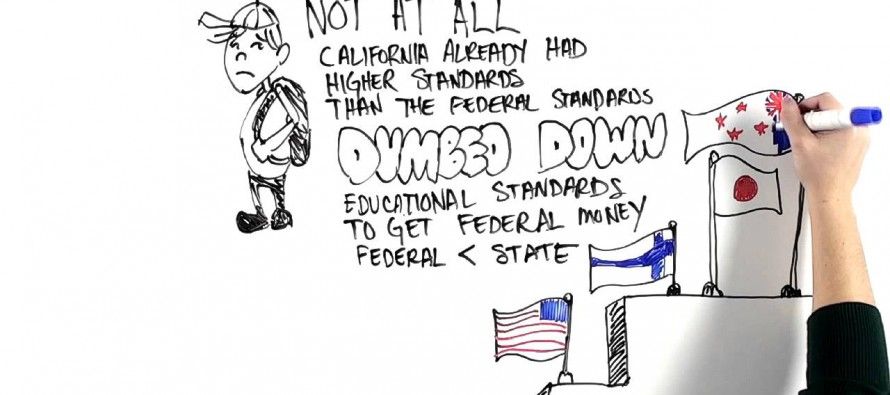Gov. Brown pushes pale education ‘reform’

By Lance T. Izumi
Around the country, governors like Bobby Jindal in Louisiana have led successful fights for new education-reform laws that eliminate or restrict teacher tenure, re-think old-line seniority protection rules and give parents the ability to choose the public or private school that best meets the needs of their children. In contrast, California Gov. Jerry Brown eschews a grand redesign of California’s dysfunctional public education system and seems satisfied merely to play small ball and tinker around the edges.
To be fair, some of the governor’s moves, though far from earth shattering, are commendable. For instance, in his recent May Revision to his 2012-13 budget proposal, Brown seeks to eliminate a number of state education mandates that have created funding inflexibilities for local schools.
His main “reform” proposal, however, which seeks to re-structure education funding through a so-called weighted-student-formula mechanism, is a pale effort that will do little to remedy the poor incentives built into the current public education system.
The first problem with Brown’s version of WSF is that it fails to incorporate some of WSF’s key commonly accepted features. Under WSF theory, a base-funding amount from the government is attached to each student, with additional amounts added for factors like low-income family background or English-language-learner status. This sum of funding follows the student to the school that he or she decides to attend. This portability of funding allows individual local schools to receive funding directly, bypassing inefficient district bureaucracies and creating competition between schools for students and the funds attached to them.
UCLA business professor William Ouchi, a leading WSF researcher and exponent, says that because funding goes to individual schools, principals “have the autonomy to decide how to allocate money for resources that include teaching staff, other employees, and extra services.” The principal is empowered to become an entrepreneur. Further, Ouchi says that a WSF system empowers parents “to choose the school they feel is best for their children.” Giving parents choice “creates a market-driven system within the public schools that will support approaches that serve students best.” Jerry Brown’s WSF plan does none of these things.
No competition
True, Brown’s WSF plan would attach base funding plus supplemental funding amounts to students, but the funds would be collected by school districts, not by individual schools, which undermines WSF’s big selling points of bypassing bloated politics-driven bureaucracies, empowering school principals, giving greater choice to parents and increasing competition between schools. In essence, Brown’s plan is just a variation on the way the state funnels money to school districts. The districts will have more flexibility on how they spend their dollars, but the anti-change incentives inherent within the system will remain basically the same.
Further, Brown conditions the implementation of his WSF system on the passage of his tax hike proposal on the November ballot. Given the lukewarm support for the proposal in the polls, the defeat of the recent tobacco tax initiative, and the state’s continuing bad economy, it is far from certain that the governor’s tax increases will win. If his tax plan loses, Brown would delay implementation of WSF.
Even if voters approve his higher taxes, he would phase in WSF implementation over a lengthy seven-year period. In other words, don’t expect a quick shake-up or quick results. As even a recent sympathetic report by Policy Analysis for California Education acknowledged, “It is a long way from this policy proposal to a fully-functioning weighted pupil funding system” that meets the objectives of a fairer, more rational and more transparent K-12 school finance system in California.
Same Education Code
In addition, Brown’s WSF proposal includes no meaningful revamping of California’s 12-volume education code. As Reason Foundation education director Lisa Snell has noted, even under WSF, “unlike an actual market system in education, public schools are still strapped with myriad local, state, and federal regulations.” The Legislative Analyst’s Office underscored the absence of regulatory reform in the governor’s proposal when it proposed an alternative plan that called for, among other things, removing state restrictions on contracting out education-related services.
Also, as I pointed out in my 2007 “California Education Report Card,” published by the Pacific Research Institute, CalWatchDog.com’s parent think tank, “WSF must operate within the confines of local teacher union contracts, which may make it much less easy to make important staffing decisions.” Not surprisingly, Jerry Brown, who signed the 1975 Rodda Act, which established teacher-union collective bargaining, makes no effort to scale back the wide scope of current union contracts.
Ultimately, the best way to make funding truly portable with students is to give parents vouchers or other school-choice tools. Parents could then send their children to the public or private school of their choosing, which would foster competition between schools, and result in better school and student performance and higher parental satisfaction.
These choice programs are also significantly less costly than the regular public school system. Louisiana, for example, expects to save money as it dramatically expands its voucher program to cover up to 380,000 students. John White, Louisiana’s superintendent of education, notes that while the state spends about $8,500 per pupil to educate regular public-school students in New Orleans, it spends only about $4,500 for every student in the city’s pilot voucher program.
Lisa Snell rightly observes: “Is it really necessary to stay within the bounds of the existing public school system and complete the difficult task of changing the system from within? A better alternative would be to move to a direct-financing mechanism through vouchers, tax credits, or charter schools — an arrangement under which per pupil funding immediately empowers parents and leads to the most decentralized schools of all, with 100 percent local budget control.” Other governors have come to this realization and have enacted wide-ranging voucher and other school-choice programs. It’s past time for Jerry Brown to have his Damascus moment, too.
Lance T. Izumi is Koret senior fellow and senior director of education studies at the Pacific Research Institute. He is the author of Obama’s Education Takeover (Encounter Broadsides, 2012). YouTube about the book:
Related Articles
CA students struggle on nationwide exams
California fared poorly in the latest round of a bellwether series of key elementary and middle-school tests. “What’s sometimes called the Nation’s Report Card,
Cinco de Mayo – "Just another wednesday"
In a staggering act of ignorance and hypocracy, five students at Live Oak High School in Morgan Hill were sent
School bond abuses: Ignoring the motive behind the scandals
Dec. 19, 2012 By Chris Reed The California media are finally beginning to figure out that school bonds are being




